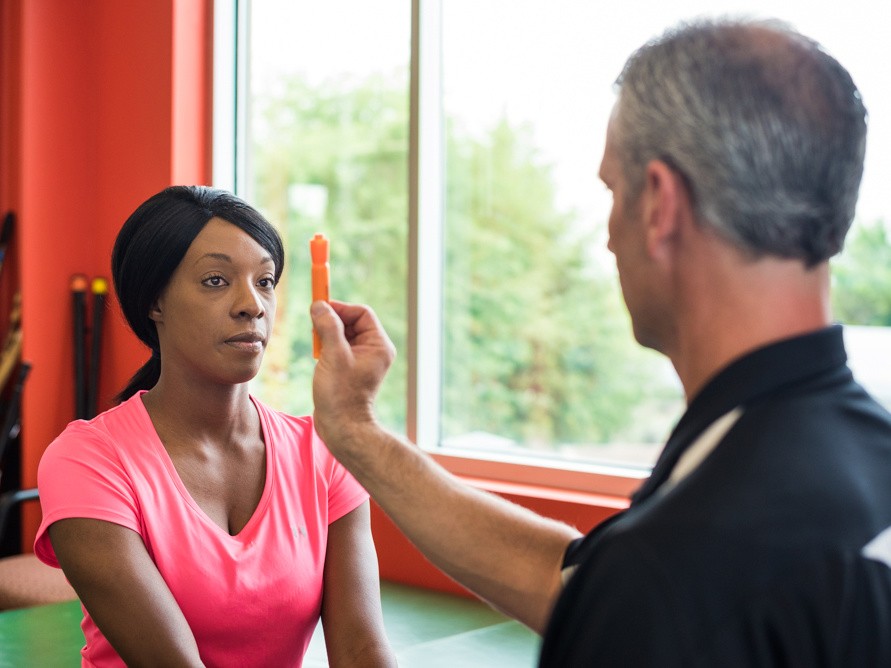Contributors:
Garrett Wasson, PT, DPT and Ryne Foster, PT, DPT, OCS, FAFS
Dizziness and vertigo are very common complaints that bring a patient to visit their physician, just as common as back pain and headaches 1 2. Vertigo can greatly affect many people’s daily lives but some do not even know that physical therapy can help! Many times, they are told the common treatment is medication or rest. However, the option of physical therapy to decrease or eliminate dizziness is an alternative and excellent option. This branch of physical therapy is called vestibular rehabilitation.
Dizziness and vertigo impact the 65+ population more than any other demographic. While something so common might not seem dangerous, up to 38% of older adults suffer from frequent dizziness and 30% cite it as the cause of their falls – in fact, dizziness is the most commonly cited cause of falls 3. Falls, and other balance related accidents, are one of the leading reasons for hospitalization among the elderly.
Vestibular rehabilitation has been shown to be effective in improving symptoms associated with dizziness and vertigo. Vestibular rehabilitation begins with diagnosing the cause of the dizziness. Some of the most common issues we see are BPPV (Benign Paroxysmal Positional Vertigo), vestibular hypofunction, and cervicogenic (postural) dizziness. BPPV is an inner ear condition that is caused by the formation of crystals within the ear’s semi-circular canals, causing moderate to severe dizziness and vertigo while changing positions.
Vestibular hypofunction is more of a general diagnosis but relates to dizziness that is caused from weakness or trauma to the vestibular nerve. Patients with vestibular hypofunction typically feel unstable or that the room is spinning. On the other hand, cervicogenic dizziness is related to neck issues caused by poor posture or significant muscle tightness and can be determined through evaluation by a physical therapist 4. Some other forms of dizziness can be from poor eye sight, medications, or issues from neurological conditions including strokes, Parkinson’s, and Multiple Sclerosis.
Are you experiencing dizziness or vertigo?
Complete this simple 5 question self-evaluation to weight the severity of your symptoms.
Download Dizziness Questionnaire
Treating Dizziness and Vertigo
One of the most common dysfunctions is BPPV. This condition can commonly be detected with physical therapy using a test called a Dix-Hallpike, which assesses for a loose crystal within one of the ear canals. The physical therapist can then use a technique called the Epley Maneuver to reposition/remove the crystal(s). In only a few treatments, these crystals can be repositioned and resolve your vertigo symptoms.
Other treatments consist of habituation exercises that re-train the brain to perceive its environment as more stable. Treatment often includes balance training on different surfaces. Even for those without true vestibular problems or BPPV, these exercises can be beneficial for reducing common occurrences of dizziness like motion sickness. Gaze stabilization is a type of habituation exercise that has been shown to improve vestibular function and balance, as well as decreasing dizziness. This technique involves focusing on a far-away object while the head is moving, as well as keeping head still and focusing on a moving object.
How Does Physical Therapy Help?
Once the cause, or causes, of your balance and/or dizziness problems are identified a physical therapist can start working on your rehabilitation plan. Your therapist will be your partner in managing your dizziness and get you back to doing the things you love with confidence.
Vestibular rehabilitation will teach you techniques required to meet your daily activity needs without fatiguing. Each set of exercises will be based on your individual needs and are designed to help improve your balance, strength, and flexibility.
Vestibular rehabilitation is also designed to treat the neurological conditions related to dizziness. Rehabilitation can be tailored to help the brain correct differences in the inner ears, improve nerve connections between the eyes and ears, stabilize your vision, and improve nerve connections along the neck and spine. Each of these focused treatments will give you better control of your body and reduce the risk of dizzy spells 4.
Therapists at Spooner Physical Therapy demonstrate advanced knowledge, experience, and skills to help fight dizziness, increase balance and muscle control, and improve your overall quality of life.
Learn more about Vestibular Rehabilitation at Spooner Physical Therapy. Ready to schedule an appointment? Schedule an appointment or complimentary movement screen with a Spooner physical therapist at one of our locations throughout the valley.
References
- McDonnell MN, Hillier SL. Vestibular rehabilitation for unilateral peripheral vestibular dysfunction. Cochrane Database of Systematic Reviews 2015, Issue 1.
- Herdman SJ. Vestibular rehabilitation. Curr Opin Neurol; 2013:26:96-101.
- Melinda Ratini, D. (2020, 20 Feb). What Is the Dix-Hallpike Test for Vertigo?. Retrieved from WebMD.com: https://www.webmd.com/brain/dix-hallpike-test-vertigo
- Mayo Clinic Staff. (2020, Apr 15). Dizziness. Retrieved from Mayo Clinic: https://www.mayoclinic.org/diseases-conditions/dizziness/symptoms-causes/syc-20371787


